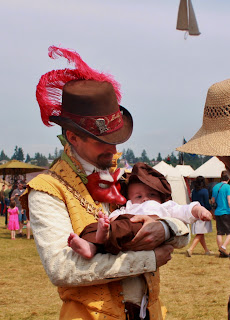As you know, my recent efforts in the realm of costuming has been on the side of the upper middle class and lower noble caste. But now that I've spent the summer shaking babies and kissing hands, it is time to launch my new project: The School of the Renaissance Artisan and that means new clothes.
Like a renaissance Springsteen, I return to my blue collar roots.
I really should stop saying things like that. No one can live up to expectations like that. Nevertheless, baby I was born to run...
Ahem.
To be completely honest: For this project I won't be wearing a costume the whole time. Only when I think it will change the outcome, or if images need to be made of the process or when it won't unnecessarily impede my progress through a public space.
There's a lot of research to be done; there's no reason to wear galligaskins to the library.
This woodcut is the inspiration for the workingman's outfit I am about to make.
An English chap of the mid 1560's stands against a tree, a working stiff of some sort, tools arrayed in a pile at his feet. I've heard him called a surveyor because of the dividers in the foreground, but I'm not so sure. There's also a pick axe, handsaw, and claw hammer. Not to mention the apron the man's wearing, which makes more sense for a carpenter or something than for a surveyor.
I like the elegant simplicity of it. I read this as galligaskins (probably of wool), plus a doublet and jerkin. Worn with a vestigial ruff at the collar, probably attached to the shirt collar. Made in appropriate fabrics and with the correct accouterments, it should pass unnoticed in any tavern, field, or guildhall of the 16th century.
It's perfect for my needs.
The first version I plan to make will be grey wool bottoms and white fustian or wool top. A simple color scheme that works well and adheres well to what we know from the research being done into English wills of the period by Ninya Mikhaila and Jane Malcolm-Davies. According to their research into the wills of the county Essex, 40% of doublets mentioned were leather, 24% linen canvas, and 21% fustian. I might make another leather doublet at some point but at the moment, I'm a bit leathered out. So fustian it is!
Clockwise from the upper left, in our fabric stash I found a nice grey wool, a heavy unbleached fustian canvas, a lighter white fustian, and a pale green linen tablecloth to use as a lining.
Yes, a table cloth. Why not? It will make a nice lining for the Gascon hose.
More tomorrow.

.jpg)

.jpg)
Wonderful blog
ReplyDeleteThanks for this information.It is very useful for all readers.
ReplyDeleteTravel Leather Goods